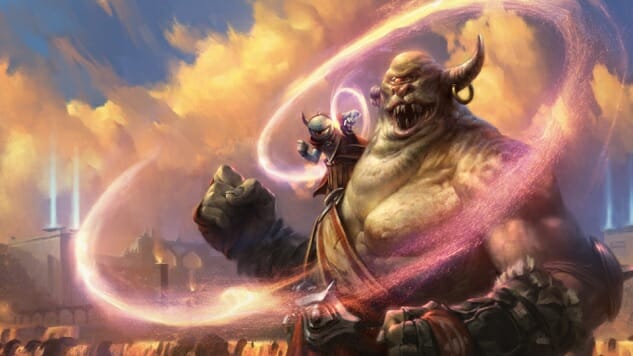Battlebond Is Magic for Two, with Fascinating Results
Art courtesy of Wizards of the Coast Games Features Magic: The Gathering
I often talk about Magic: The Gathering being the best game ever made, and the reason that I sometimes have an upswell of that opinion is that it is a modifiable experience. The rules, although complicated, are so robust that they can be adapted to almost any kind of play situation, and Two Headed Giant is one of those situations. Magic is normally a 1v1 game where you sweatily and with great vigor attempt to defeat your opponent, but Two Headed Giant is a variant of the game that was sanctioned by developer Wizards of the Coast back in the early 2000s to allow you and a good friend to team up and play a 2 v 2 game against another duo (perhaps your nemesis). While the format has existed for more than a decade in an official capacity, there haven’t been many Magic releases that were created with Two Headed Giant play in mind. That has changed with the new summer set named Battlebond, which comes out June 8th.
Wizards of the Coast have very nicely sent me some Battlebond cards to check out, and the full spoiler of the card list has been revealed. I can confidently say that the set is doing some really interesting things, both in the context of Magic in general, and in the context of Battlebond as a set that you can draft or play with in a sealed format.
The thrill of Two Headed Giant as a format is playing a “big” game of Magic. You and your friend, or at least your teammate, are both two “heads” sitting atop one game-playing body, and as such you take your turns together, talk about what to do, and generally try to best that duo across the table. A lot of the time, Magic is a game about small interactions. You’re counting mana, trying to be as efficient as possible, managing the cards in your hand, and trying to think about tiny percentages of upside that you can generate over the person you’re competing against. Two Headed Giant has some of that, but it has just as much “I am going to play as many big angels, sea monsters and demons as I can, then I’m going to smash them into you” in it.
By its very nature, Two Headed Giant rewards those crunchy plays, the massive creatures, and the weird combos, and Battlebond is great because it is an entire set designed around that interaction. For example, a new mechanic that appears here is called “Partner.” When a creature with Partner enters the battlefield, a target player (who could be either you or the other “head” on your team) can search their deck for another card. When Pir, Imaginative Rascal lands in the game, your teammate can then search their deck for Tooty, Imaginary Friend. So being partners really does feel like this gladiatorial, splashy thing when my heavy hitter comes out and brings my buddy’s heavy hitter out at the same time.
That mechanic is just a little bit of the design ethic of Battlebond, which seems almost singularly designed to bring groups of people together to play Magic. Similar to their Commander offerings from the past few years, Wizards of the Coast are showing a commitment to all of the different ways that players have concocted to play and have fun with the 25 years of cards and sets that have been released. The fact that this is a physical card game that has been continually going for that long is impressive, but just as important is the reality that the game is constantly changing to accommodate changes in the player base and what they want to be doing with the game.
All of that said, I think that Battlebond occupies a weird place in the Magic world. I think it would be very hard to teach someone how to play the game with this set, but I also think that those who might enjoy it most are newer players whose minds have not been shuttered to novelty and the thrill of discovery in the game. Maybe the best way to do it would be to teach someone to play with a pre-made deck and them immediately get them into Battlebond. In either case, no matter who it is “for,” the set shows a real willingness on the part of Wizards of the Coast to expand their offerings to players who want to do more fringe activities, and that’s always worth doing in my book.
Cameron Kunzelman tweets at @ckunzelman and writes about games at thiscageisworms.com. His latest game, Epanalepsis, is available on Steam.